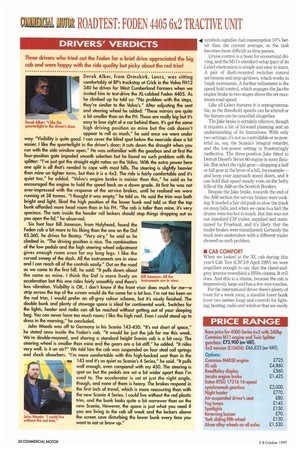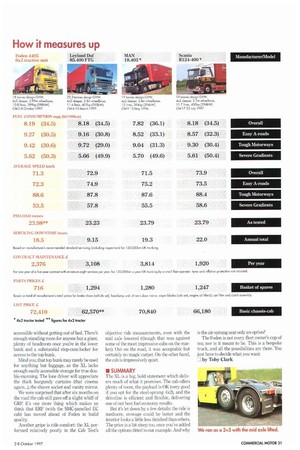• straightforward reprogramming turns it into the M405E, putting out
Page 30

Page 32

Page 33

If you've noticed an error in this article please click here to report it so we can fix it.
a true 399hp (298kW) and a peak torque of 1,4751bft (2,000Nm)— almost 10% more than the M380E, at the same 1,200rpm. There are no mechanical changes to the engine, but the 4405 gets an uprated cooling package.
Other engine options for this model include Cummins' N14, the Perkins Tx and Caterpillar's C10 and 3406E.
Foden has long favoured Eaton/Fuller gearboxes, and the last 4405 we tested (CM 4-10 September) was an 8x4 tipper fitted with the RI 13-speed unit. The 4405 gets the Twin Splitter as standard (Eaton's TS() 12612) but this version used Eaton's S-Series, which has already proved a worthy alternative to ZF's Ecosplit. The ratios are similar, 8L being direct drive and 8H being a 0.83:1 overdrive: the ZF box gives 0.84:1 in top.
The drive axle is the ubiquitous Rockwell S180E, with the same 3.91:1 ratio that performed so well in the Fuel Duel ERF and the Detroit Diesel-powered ERE • PRODUCTIVITY Eight miles per gallon has become an important psychological benchmark for manufacturers who put their vehicles round CM's Scottish route. If a fully-laden 38-tonner can beat 8mpg round the route, it's in the best company, and both Cummins and Foden can make that claim. The 4405 delivered an over all figure of 8.19mpg in less than perfect conditions; a tiny fraction better than the 400hp Leyland Daf and Scania opposition, and a clear challenge to the 380hp ERF EC11 which currently holds the economy record round our Scottish test route.
An average speed of 71.3km/h is also well up to par, with a particularly strong performance on the tough motorways of the last day. The Foden spent a good deal of time with the cruise control set to the speed-limited maximum of 54mph, putting out enough torque (at just over 1,400rpm) to take most hills in top gear.
Where the 6x2 does fall down is in payload, but it's not as weighty as it might be, coming in at a fraction over eight tonnes with a driver and a full tank. This compares well with the Leyland Daf 85.400F1'G, a twin-steer with a much smaller cab, which weighs in at 7.77 tonnes. The steel-sprung 4x2 variant would deliver a very competitive 23.98 tonnes of payload, just a smidgen behind the smallercabbed ERF EC11, while air suspension would reduce that figure by 193kg.
• ON THE ROAD For years now Fodens have been impressing us with the precision of their steering and this was no exception. It tracked the bumpy, rollercoaster A68 as well as the tramlined Al.
As with every M11 we've tested, the engine's power delivery is smooth and pre
dictable, with no nasty surprises in the torque curve. Once you're accustomed to making full use of the low-down torque, rather than revving the engine for power, efficient and economical driving is easy.
The engine does offer one surprise, however: its "take-off torque" feature makes a high proportion of maximum torque available at tickover for easy getaways. The temptation to brush the accelerator during hill-starts is almost unbearable, but it only results in broken traction and kangaroo hops.
Eaton's S-Series is generally a lovely gearbox which has proved its quality in a number of previous tests. But what has Foden done here? It's gone and used its confounded cableoperated gear linkage again. The smooth, slick shift we're used to becomes a tangle of knitting needles. It's not unbearable: with a light touch and some practice the changes are quite quick, but any hint of indecision or imprecision baulks the box at every turn. Selecting the split early, being sure to depress the clutch fully and giving the lever a little time in neutral all help the cause.
Road Relay is undoubtedly useful for the fleet operator, and is likely to generate a good deal of valuable management information, but its most important role may be psychological: the readout of average fuel consumption is a constant challenge to the driver. Few could resist trying to get one or more “+” signs up on the display and each one of these II. symbols signifies fuel consumption 10% better than the current average, so the task becomes more difficult as time passes.
Cruise control is a boon for economical driving, and the M1 l's standard setup (part of its Celect electronics) is simple and easy to learn. A pair of dash-mounted switches control set/resume and step up/down, which works in lmph increments. A further refinement is the speed hold control, which engages the Jacobs engine brake in two stages above the set maximum road speed.
Like all Celect features it is reprogrammable, so the threshold speeds can be altered or the feature can be cancelled altogether.
The Jake brake is certainly effective, though it requires a bit of forward planning and an understanding of its limitations. With only two settings, it's not as controllable or as powerful as, say, the Scania's integral retarder, and the low-power setting is frustratingly ineffective. The three-position Jake fitted to Detroit Diesel's Series 60 engine is more flexible. But select the right gear—dropping a half or full gear at the brow of a hill, for example— and keep your approach speed down, and it can hold that speed steady even on the hefty hills of the A68 on the Sottish Borders.
Despite the Jake brake, towards the end of the A68 section the service brakes were cooking. It needed a fair old push to slow the truck on steep hills, and when we came to a halt the drums were too hot to touch. But this was not our standard CM trailer, supplied and maintained by Fruehauf, and it's likely that the trailer brakes were misadjusted. Certainly the track tests undertaken with a different trailer showed no such problem.
• CAB COMFORT
When we looked at the XL cab during this year's Cab Test (CM 3-9 April 1997) we were ungallant enough to say that the claret-andgrey interior resembled a 1950s cinema. It still does. And this is a shame, because the cab is impressively large and has a few nice touches.
For the international driver there's plenty of room for a week away, a sizeable lower bunk (over two metres long) and controls for lighting, heating, radio and window that are easily accessible without getting out of bed. There's enough standing room for anyone but a giant, plenty of headroom once you're in the lower bunk and a substantial step-cum-locker for access to the top bunk.
Mind you, that top bunk may rarely be used for anything but luggage, as the XL lacks enough easily accessible storage for true double-manning. The lone driver will appreciate the thick burgundy curtains (that cinema again...), the shaver socket and vanity mirror.
We were surprised that after six months on the road the cab still gave off a slight whiff of GRP It's one more thing which makes us think that ERF (with the SMC-panelled EC cab) has moved ahead of Foden in build quality.
Another gripe is ride comfort: the XL performed relatively poorly in the Cab Test's objective ride measurements, even with the mid axle lowered (though that was against some of the most impressive cabs on the market). Out on the road, it was acceptable but certainly no magic carpet. On the other hand, the cab is impressively quiet.
• SUMMARY The XL is a big, bold statement which delivers much of what it promises. The cab offers plenty of room, the payload is OK (very good if you opt for the steel-sprung 4x2), and the driveline is efficient and flexible, delivering one of our best fuel economy results.
But it's let down by a few details: the ride is mediocre, stowage could be better and the interior looks a little less finished than others. The price is a bit steep too, once you've added all the options fitted to our example. And why is the air-sprung seat only an option?
The Foden is not every fleet owner's cup of tea; nor is it meant to be. This is a bespoke truck, and all the possibilities are there. You just have to decide what you want.
by Toby Clark








































































































